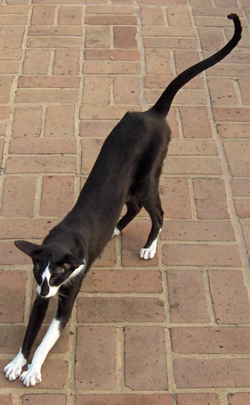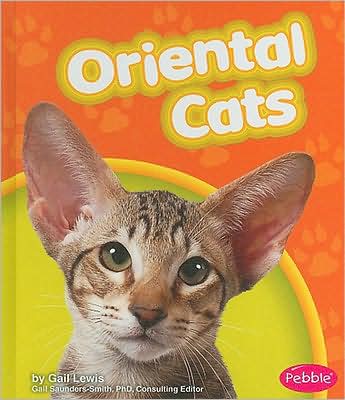History
The Oriental breed was developed in the 50's and 60's using the Siamese as the foundation. The original Oriental was a short-haired cat that was very similar to the Siamese but available in a huge array of patterns and colours. The Oriental Longhair was developed later by crossing with the Balinese. Today the Oriental (both short and long hair) has been combined into one breed division and is recognised in the Championship class by all of the major cat associations.
Description
The conformation or body type of the Oriental is pretty much the same as the Siamese - it has a long and svelte body with firm muscles and a surprising heaviness when picked up. It has tall slender legs. The head is a long tapering wedge with a fine muzzle and a long and straight nose. The ears are large, wide at the base and pointed at the tip. The eyes are medium sized and almond shaped - slightly slanted towards the nose. The eyes are green except for the white Oriental that may be blue, green or even odd coloured! The tail is long and thin at the base, tapering to a pointed end.
The Oriental was bred to explore all varieties of colour and pattern and there are over 300 different colours and patterns to choose from. The most common colours are solid ebony, white, chestnut, blue and ebony tabby. Including the pattern combinations there are 112 tabby combinations alone!
Size
Medium
Coat
The shorthair has a fine-textured satin like coat that lies close to the body. The longhair is medium length with fine silky hair. There is no undercoat and the tail hair is the longest.
Temperament
The Orientals personality is also bright and colourful. They are extroverted cats that are full of energy and enthusiasm for the world around them. They are very curious and will want to be involved and consulted about all of your daily activities. They usually bond closely with one human and will become very devoted. Like the Siamese they are also extremely talkative although their ‘voice' is a little softer than the Siamese.
Health
Generally a healthy breed, the Oriental does not need a lot of intensive care. Because the longhair does not have an undercoat they do not need a huge amount of grooming (like the Persian) - but will require regular brushing.
Possible Genetic Disorders
In terms of genetic defects they tend to suffer the same problems as the Siamese which include:
- Endocardial fibroelastosis
- Gingivitis-periodontitis, feline juvenile-onset
- Mucopolysaccharidosis
- Mucopolysaccharidosis VI
- Porphyria
Best Suited
Because of their intense bonding and need to be involved in their human's life, the Oriental does not do well if neglected. They are very dependent emotionally and will become quite depressed if not included in every part of your life. This breed needs an owner who wants a close feline companion and is prepared to meet their emotional needs.
Recommended Reading 
Oriental Cats by Gail Lewis



